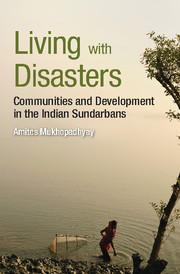Book contents
- Frontmatter
- Dedication
- Contents
- Maps and Illustrations
- Tables and Charts
- Glossary
- Acronyms
- Acknowledgements
- Note on Transliteration
- Maps
- Illustrations
- Charts
- 1 Introduction
- 2 From Wasteland to Wonderland: The Making of a Heritage Site
- 3 Governing the Sundarbans Embankments Today: Between Policies and Practices
- 4 Treading a Fine Path between River and Land: Livelihoods around Embankment
- 5 Beldars, Embankment and Governance: Question of Aboriginality Revisited
- 6 Catching Prawn, Endangering Embankments: Sustainability-Unsustainability Rhetoric
- 7 Conclusion
- Bibliography
- Index
6 - Catching Prawn, Endangering Embankments: Sustainability-Unsustainability Rhetoric
Published online by Cambridge University Press: 05 March 2016
- Frontmatter
- Dedication
- Contents
- Maps and Illustrations
- Tables and Charts
- Glossary
- Acronyms
- Acknowledgements
- Note on Transliteration
- Maps
- Illustrations
- Charts
- 1 Introduction
- 2 From Wasteland to Wonderland: The Making of a Heritage Site
- 3 Governing the Sundarbans Embankments Today: Between Policies and Practices
- 4 Treading a Fine Path between River and Land: Livelihoods around Embankment
- 5 Beldars, Embankment and Governance: Question of Aboriginality Revisited
- 6 Catching Prawn, Endangering Embankments: Sustainability-Unsustainability Rhetoric
- 7 Conclusion
- Bibliography
- Index
Summary
Tiger prawn seed and Baishakhi as a catcher
Baishakhi Sardar, a resident of Jagatpur, lost her right arm three years back. She was catching tiger prawn seeds (locally called bagda/bagda min) in waist-deep water when a shark or kamot attacked her. It caught hold of her right arm and dragged her into deep water. Baishakhi's left hand firmly held on to the fishing net and in desperation she kept hitting the kamot with the wooden frame of the net. Sensing the danger, those fishing with Baishakhi rushed to her rescue. They grabbed her by the waist and tried hard to get her out of the grip of the kamot. Finally, they succeeded, but at the cost of her right arm. Baishakhi was unconscious as she bled profusely. She was in hospital for months before she came back home. While narrating the incident during my visit to her house in Jagatpur, Baishakhi confessed that she still went to the river to catch tiger prawns.
The Sundarbans is a land where fishing folk coexist with those who go to the forest in search of wood or honey. With rivers flowing around the settled and forested islands, fishing becomes a very important activity for the people. People set out on boats to fish at the confluence of rivers and the Bay of Bengal. They also catch fish or crab in the narrow creeks inside the forest. At times, two to three boats are anchored in the middle of the river and nets are cast wide with one end tied to the boats. Fishermen often spend hours and days catching fish. This chapter focuses on the fishers, but not on the so-called traditional fishing communities. Rather, I focus on the women tiger prawn seed catchers such as Baishakhi and people who are involved in prawn collecting, farming and trading in the Sundarbans. It is against the background of raging debates about the environmental sustainability of prawn farming, particularly in the coastal regions, that the chapter delves into the dynamics of prawn trade. However, the chapter does not look into a struggle between the state and fishing community as has been done by Jaladas (2013) in his research on the eviction of fishermen from the Jambudwip island on grounds of violating the state forest act.
- Type
- Chapter
- Information
- Living with DisastersCommunities and Development in the Indian Sundarbans, pp. 117 - 145Publisher: Cambridge University PressPrint publication year: 2016

